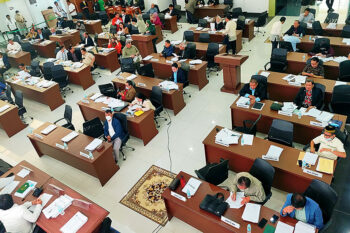GENERAL SANTOS CITY (MindaNews/09 March) — When people ignore laws – statutory and natural; when authorities neglect their authority or default on the use of it to enforce laws; and when caretakers don’t take care, trouble is not far behind or looms ahead. Such is the case of Lake Sebu, the lake after which the municipality where it is located has been named. Worse!Trouble is not just catching up or threatening ahead but has enmessed the Lake without sign of ending.
MindaNews last March 6 headlined the latest situation: “35 illegal structures in Lake Sebu demolished.” The story reported the account of Lake Sebu Mayor Antonio Fungan at a radio interview in General Santos City on that day. The mayor sounded stern: Demolished were “35 illegal structures in parts of Lake Sebu as part of the continuing massive cleanup of the critical lake.” Started two weeks earlier, the mayor vowed the cleanup would not stop until the lake has been cleaned. No end has been set. The vow is as eternal as eternity is without end.
The “35” included two concrete resort cottages, six semi-concrete cottages and 27 fish cages This was just the initial figure of the first phase of the “massive cleanup” targeting “resort cottages, fish cages and other structures situated in the initial 20 meters from the lakeshore and those located near the outlets of the lake” and shanties along the lake. The next phase is to clear illegal fish cages within another 100 meters of the lake’s passage.
How serious is the situation?
Most of the lake’s designated passage ways is now crowded with illegal structures stretching two to three kilometers from the lake’s shores; with 5,282 tilapia mostly illegal fish cages and other structures in about 21 percent (19 percent from another source) of its area, the lake is considered overcrowded making major fish kills imminent. In two weeks, only 35 structures and fish cages have been demolished. How long will the cleanup take?
MindaNews, reported on February 4, “Illegal fish cages in Lake Sebu to be dismantled”, the plan to dismantle the illegal fish cages as Siegfred Flaviano, the provincial environment management officer of South Cotabato had revealed in a media forum. To be dismantled were “fish cages that have no proper permits, owned by unlicensed operators and those sub-leased by their original owners.” This was the same plan reported by Mayor Fungan as being done. The provincial and municipal governments are cooperating in regulating the use of Lake Sebu.
Flaviano revealed: First, mismanagement is inefficient and evidently tainted with corruption. The ordinance prohibits sub-leasing. Yet, 80 percent of the fish cages at the lake had been so far sub-leased to traders or companies in General Santos City and Davao City. Despite the big number of fish cages, “the tax collection by the municipal government from the entire industry had been quite insignificant.”
Second, the overcrowding is beyond the carrying capacity of the lake that has caused fish kill in the last three years. With area of around 354 hectares, the lake has 371 licensed fish cage operators who, in 2013, constructed 4,586 fish pens or 13 times the lake’s carrying capacity of around 320 to 350 fish cages. The cages occupy 70.99 hectares or 19 percent of the lake’s total area in violation the Philippine Fishery Code of 1998 that allows only ten percent for aquaculture development. In six months, the area covered will be reduced to 35 hectares.
Better than Fungan, Flaviano has set a concrete target — by end of July — for which he can be accountable.
But MindaNews correspondent Allen V. Estabillo reported on August 8, 2011 or three years ago: “Officials want Lake Sebu fish cage operations regulated.” What happened?
As reported, after the fish kill in July valued at P1.04 million, South Cotabato Gov. Arthur Pingoy Jr. directed the local government’s environment and agriculture offices to conduct a comprehensive study on the status of the fish cage operations and formulate regulatory policies that would help properly manage Lake Sebu’s fishery resources. To support the urgency of his order, Pinggoy cited the same facts in subsequent reports three years after as the causes of the “massive fish kill” that had been an annual occurrence.
In Ilonggo, there’s a saying: “Kung indì paglinti-an, indì maghulag. Kung wala na ganì sing lintì, maniholtihol kag magtulog.” (Translated liberally in English, it means: “If lightning doesn’t strike, he doesn’t move. Once lightning is gone, he would whistle and go to sleep.”) That has been happening in Lake Sebu, year in and year out – from mayor to mayor, governor to governor. By Fungan’s vow, the cleaning will never stop since the lake is never cleaned.
The immediate cause of the fish kill is kamahong, a condition usually occurring during rainy season and mainly caused by the sudden rise in the water’s temperature that increases sulfuric acid in the water. At the same time this reduces dissolved oxygen in the water forcing the fish to take oxygen directly from the atmosphere causing death to the fish. The condition is worsened by overcrowding the lake and disposing waste into the lake from resort and residential cottages built over the lake and residences on the lake shore.
How serious is the damage?
MindaNews repored (February 5, 2014: “P5.2M worth of tilapia hit in Lake Sebu fish kill”) that in the last three weeks of January the tilapia industry of Lake Sebu lost 68.219 metric tons of tilapia valued at around P5.2 million due to another fish kill in the eastern and western sections of the lake affecting around five hectares of fish cages and a total of 54 operators. Rudy Muyco, the lake warden, described the fish kill as continuing.
Muyco revealed that in October 2013, around 20 metric tons of harvestable tilapia and pangasius valued at around P1 million were lost affecting some 60 fish cages. This, MindaNews reported on October 20, 2013 (”Still in a sorry state, Lake Sebu stinks for days due to fish kill,” by Bong S. Sarmiento).
In 2012, around 57 metric tons of tilapia were lost in two fish kills – 48.55 metric tons in January and more than eight metric tons in August – valued at P4.3 million affecting 62 fish-cage owners. This MindaNews also reported on January 31, 2012 (”Close to 50MT of tilapia lost in Lake Sebu fish kill”, by Allen V. Estabillo).
MindaNews, published Bong Sarmiento’a multi-series “SPECIAL REPORT: Moratorium on fish cage operations sought to save Lake Sebu from dying” starting on March 10 2013, presenting a clear picture and an intensive analysis of the Lake Sebu problem. It covered practically the same conditions and causes recited by the sources of the reports in the last three years, the latest, last March 6.
Why is the problem seemingly unending?
The municipal ordinance and the national fishery code regulating the tilapia industry in the lake are not properly and strictly enforced. The lake, by the law of nature, can support just “this many tilapias,” other fish and vegetation. More than “this” it will become the “death chamber” of the tilapias. Indeed, it has become so by filling it with tilapia 13 times the number it can carry and polluting it to worsen the kamahong effect. So, the yearly fish kill!
The state of stupidity is imponderable. The authorities concerned know that all they have to do is to enforce the laws strictly and properly. Yet, they only promise to but don’t do it. In their insatiable thirst for profit, more and more investors violate the statutory and natural laws only to end up in heavy losses. Yet, they keep on violating and investing.
From its archive, MindaNews can dig out reports to tell when it started reporting the Lake Sebu problem. It must have been be years before 2011. We will not be surprised if it will be reporting the problem many more years after 2014.
[MindaViews is the opinion section of MindaNews. Mind da News, the alternate of COMMENT, is an opinion on current news. The author may be contacted at patponcediaz@yahoo.com.]







